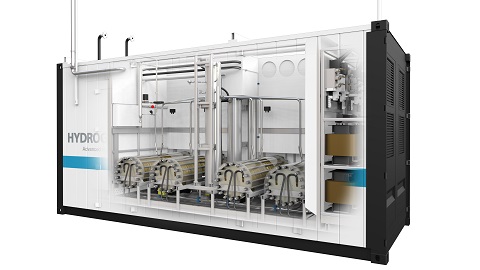A developer and manufacturer of hydrogen generation and hydrogen-based power modules says that E.ON has inaugurated commercial operations at its Power-to-Gas (P2G) facility in Falkenhagen, Germany. The plant uses wind-powered electrolysis equipment from Hydrogenics Corp, (www.hydrogenics.com) to transform water into hydrogen, which is then injected into the existing regional natural gas transmission system. The hydrogen, as part of the natural gas mix, will be used in a variety of applications including space heating, industrial processes, mobility, and power generation. The 2-MW facility will produce 360 m3 of hydrogen/hr.
“This project makes E.ON one of the first companies to demonstrate that surplus energy can be stored in the gas pipelines to help balance supply against demand,” says CEO of E.ON Deutschland Ingo Luge. “This storage method is considered key technology for the transformation of Germany’s energy system. It will reduce the need to take wind turbines offline when the local grid is congested and will let us harness more wind power.”

E.ON and Swissgas will begin commercial operations at the power-to-gas facility in Germany using Hydrogenics electrolyzers. The 2-MW facility will produce 360 cubic meters of hydrogen/hr.
Swissgas, which represents over 100 local natural gas utilities, is a partner in the project with a 20% capital stake and an agreement to purchase a portion of the gas produced. “Swissgas’ involvement demonstrates the significant value of Switzerland’s gas infrastructure, which lets us transport and store regenerative energy across national boundaries,” says Heinrich Schwendener, a member of the organization’s Board of Management.
Daryl Wilson, CEO of Hydrogenics, added, “In April of this year we announced a second Power-to-Gas project with E.ON for the city of Hamburg. That facility, still under construction, will have the world’s largest single megawatt PEM (electrolyzer) stack and expects delivery in the spring of 2014. These projects serve as a platform for upcoming Power-to-Gas facilities in Europe and around the world.”
“One of the biggest challenges of transforming Germany’s energy system is finding ways to integrate the increasing share of intermittent, renewable-source energy,” says Germany’s Economics and Technology Minister Phillip Rosler. “To ensure that Germany’s power system remains stable and our economy continues to have the energy it needs, we have to rapidly expand energy networks and require innovative solutions such as the P2G unit here in Falkenhagen.”
For Hydrogenics, this has been a turnkey Power-to-Gas project which included supply, installation, connection, and commissioning of the hydrogen production facility including gas compression, master controls, as well as a five-year service and maintenance agreement. WPE&D
Filed Under: Energy storage, News, Projects






I agree wholeheartedly with Matt Balder’s comment that hydrogen generated using surplus off peak wind generated electricity could be used to power vehicles. Clearly there would be safety issues with the local generation of hydrogen at filling stations, perhaps some form of swappable gas cassettes might remove some of the hazards.
For the first time on an industrial scale, hydrogen produced using wind power is being injected into the natural gas grid in Germany. It’s a development that could enhance the value of wind power by making it useful no matter when it is produced.
Compare Electricity
I am very intrigued by this wonderful progression that we are at the cusp of with this milestone. I look forward as well to the development of medium and small scale implementations of this generation technology. Can anyone see this being coupled with a hydrogen vehicle refueling network that could be implemented by any easy conversion of most gasoline stations?
The Novaccu Ltd. has a systems technology of a new type of electrical energy
storage battery what is “NOVACCU BATTERY” which is suitable the electricity supply of
the electric cars.
This equipment is the energy storage of the future whereat you can build a new industry.
In the short features:
• Fast recharge option: to upload to 100% it takes a few minutes
• High energy density
• Eco-friendly electricity supply
• The stored energy in the battery of the NOVACCU can be stored indefinitely without
loss years or more and no self-discharge
• A further advantage of technology to transport is absolutely harmless
Potential uses:
• The storage of the NOVACCU can be replaced the power supply of the coal-powered
vehicles
• It is suitable electrical energy storage generated by the solar- wind- water and nuclear
power industrial quantities
• It is suitable to store electricity to drive electric vehicles
We want to sell the entire technology of “NOVACCU BATTERY”
The Novaccu Ltd. is the sole owner of the technology, and the technology is not patented, but
we do not want to patent, we want to sell the technology.
Data sheet of Novaccu battery
Novaccu 15 kW
delivered power 3750 Ah
outside size
80*80*40 cm
weight 17 kg
capacity 15 kW/h
self-discharge no
operating voltage 4 V
If you would like to contact us in orally, you need an interpreter Novaccu Ltd.
Company for Production, Development and Trading of Chemical Power
Address : Hungary H-1158 Budapest Késmárk utca 8- 10
Mobile: 0036-70-626-3828
Email: novaccu@gmail.com
Hungary Budapest
Mr. Vincze György